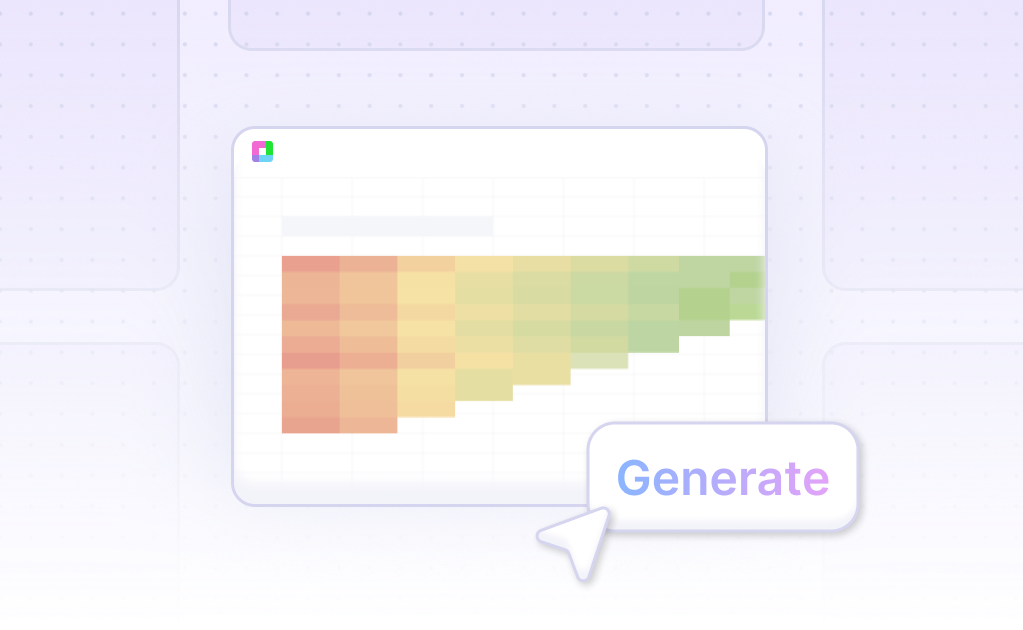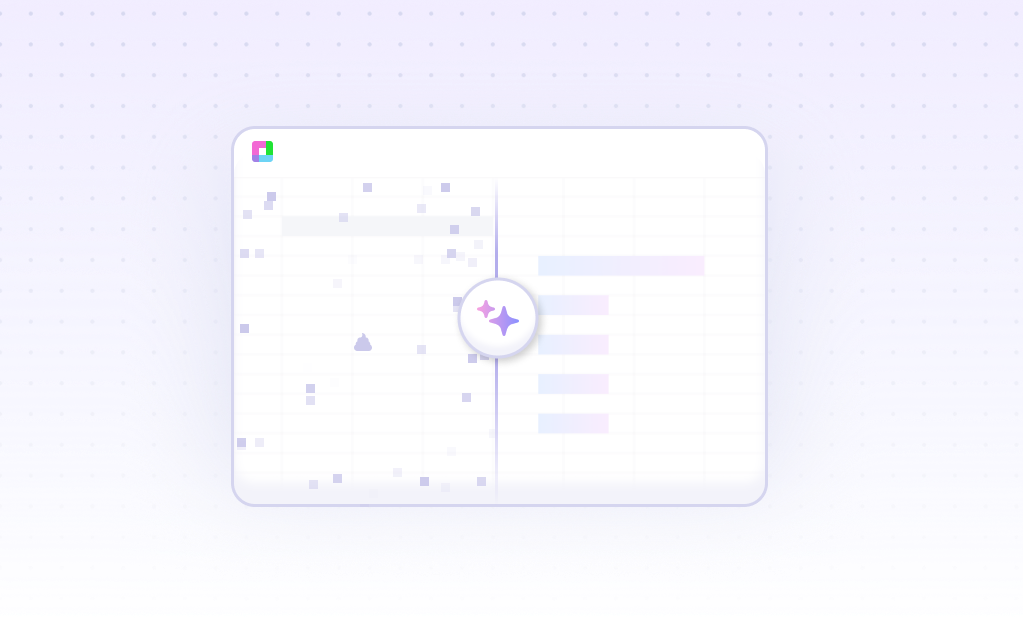
Introduction
Creating a Clustered Column - Line Chart can help visualize complex datasets by showing trends and comparisons clearly. Whether using AI-powered tools like Sourcetable or traditional spreadsheet programs such as Excel and Google Sheets, the process can be straightforward. Sourcetable simplifies this further with its AI spreadsheet that enables users to excel at spreadsheet tasks.
The AI assistant in Sourcetable assists in crafting charts, graphs, and templates effortlessly, allowing you to focus on analysis rather than data management. For users familiar with traditional spreadsheets, switching to an AI-powered spreadsheet with Sourcetable could enhance productivity. The integration of AI reduces the typical complexity associated with generating detailed charts.
If you're ready to create your first Clustered Column - Line Chart using AI, or if you want to discover how to use traditional spreadsheet tools for the same, keep reading for detailed instructions. Alternatively, you can sign up for Sourcetable to start right away.
What is a Clustered Column - Line Chart?
Definition of Clustered Column - Line Chart
A clustered column chart is a vertical bar chart that includes a group of bars for every primary category. Similar to bar charts but with vertical columns, clustered column charts allow you to chart subcategories and measure data over multiple dimensions. They are ideal for comparative analysis and for measuring data over time. By combining with a line chart, this visualization can display target sales values as columns and actual sales as markers on the lines.
Uses of Clustered Column - Line Chart
Clustered Column - Line Charts are useful for displaying three categories, such as Alpha, Beta, and Gamma, and three series, like Red, Green, and Blue. They utilize clustered columns for the series and lines for target and actual sales data, enhancing insight in visual analysis. They allow for the comparison across multiple series and the measurement of data over time.
How to Create a Clustered Column - Line Chart
To create a Clustered Column - Line Chart, start by selecting the cells you want to chart. Change the chart type of one or more data series to Clustered Column - Line. Incorporate a secondary vertical axis for data series with different value ranges, enabling comparison of distinct metrics like temperature and precipitation.
Benefits of Clustered Column - Line Chart
Clustered Column - Line Charts add value and insight to visual analysis by allowing for detailed comparison across multiple series. They are great for measuring data over time and are perfect for comparative analysis. These charts combine the familiarity of bar charts with enhanced detail, making them superb for visualizing large datasets.
When to Use a Clustered Column - Line Chart
Overview
A Clustered Column - Line Chart is useful for comparing different categories over the same period. It combines a column chart and a line chart to show both individual data points and trends. Use it when you need to visualize multiple data series with distinct units in a single chart.
Pros
Clustered Column - Line Charts offer several advantages. They integrate different data series, making it easy to distinguish trends and differences among categories. The dual visualization aids in highlighting individual values and overall trends simultaneously. This chart is particularly effective in showing the relationship between different data sets.
Cons
However, they can be complex to interpret if overused. Too many data series may clutter the chart, making it difficult to read. This type often requires additional explanation, which can detract from its convenience. Choosing the correct scale for both axes is crucial to avoid misleading representations.
Comparison with Other Charts
Compared to simple column charts, Clustered Column - Line Charts provide more depth by adding trend lines. However, they are more challenging to create and interpret. Line charts are more straightforward for displaying trends over time but lack the categorical breakdown that clustered columns offer. Bar charts offer categorical comparisons but do not show trends as effectively.
How to Generate a Clustered Column - Line Chart with Sourcetable
- Sourcetable, an AI spreadsheet, simplifies creating a Clustered Column - Line Chart. Rather than manual methods used in Excel or Google Sheets, Sourcetable AI offers an easier approach.
- Begin by creating sample data using Sourcetable's AI assistant or by uploading a CSV. This serves as the foundation for your Clustered Column - Line Chart. Selecting a range of data is the next crucial step. Ensure the data you select is accurate and relevant.
- After selecting your data, ask the AI assistant to generate the Clustered Column - Line Chart. This step minimizes manual effort and accelerates the process. Adjusting and refining the chart is simple with the AI assistant. Specify changes such as formatting, labels, and other preferences for a polished final result.
How to Generate a Clustered Column-Line Chart in Excel and Google Sheets
Clustered Column-Line Chart in Excel
To create a Clustered Column-Line Chart in Excel, first select the data series you want to include in the chart. Click on the chart, then under CHART TOOLS, click DESIGN. Next, click Change Chart Type.
In the All Charts tab, choose Combo and select Clustered Column-Line on Secondary Axis. Check the box for Secondary Axis for each data series that should use the secondary axis. Set these data series to Line and the other data series to Clustered Column.
Clustered Column-Line Chart in Google Sheets
To create a Clustered Column-Line Chart in Google Sheets, start by setting up your data in two columns: the left column for the primary data series and the right column for the secondary data series. Select the data you wish to include in the chart.
Click Insert in the main menu, then choose Chart. In the chart editor, use the Chart Type drop-down menu to select Combo Chart. Customize the chart as needed to display the clustered columns and line data appropriately.
Key Steps for Both Excel and Google Sheets
Select the data to display in the chart. Click the Insert menu and select the Chart option. For Excel, change the chart type to a Combo Chart and add a secondary axis. For Google Sheets, use the Chart Type drop-down menu to select a Combo Chart.
Use Cases Unlocked by Visualizing Data with a Clustered Column - Line Chart
Comparative Sales and Revenue Analysis |
A Clustered Column - Line Chart facilitates a detailed comparative analysis of sales and revenue over a specific period. Users can easily identify trends and correlations between sales volumes and revenue generation, leading to informed decision-making for marketing and sales strategies. |
Performance Benchmarking |
Businesses can use this type of chart to benchmark performance across different product categories or departments. The clustered columns show individual performance, while the line graph indicates overall growth or decline, providing comprehensive insights into organizational performance. |
Resource Allocation Insights |
Visualizing resource allocation versus output in a Clustered Column - Line Chart helps in identifying the efficiency of resource use. It enables managers to reallocate resources for optimal productivity based on performance data represented in the chart. |
Marketing Campaign Evaluation |
The chart is ideal for assessing the effectiveness of marketing campaigns by comparing pre and post-campaign performance. The line graph can show overall impact, while the clustered columns can highlight specific campaign elements that performed well or poorly. |
Seasonal Trend Analysis |
Businesses can leverage this chart type to analyze seasonal trends by comparing sales or performance metrics across different time periods. It assists in identifying peak seasons and making data-driven inventory or staffing decisions accordingly. |
Financial Forecasting |
Clustered Column - Line Charts are useful in financial forecasting by comparing past financial data with projected outcomes. The visual representation helps in identifying deviations from forecasts and making necessary adjustments to financial plans. |
Frequently Asked Questions
Why doesn't my line value align with the actual value?
Use a scatter series instead of a line series to align markers on the scatter series over the columns.
When should I use a combo chart for data visualization?
Use a combo chart when you have a line chart and a column chart with the same X axis, need to compare measures with different value ranges, want to illustrate correlation between two measures, check if one measure meets a target defined by another measure, or save space on the canvas.
What are the benefits of using a Clustered Column - Line Chart?
Clustered Column - Line Charts add value and insight to visual analysis, allow for comparison across multiple series, and are perfect for comparative analysis.
How can I avoid a cluttered chart when using multiple series?
Avoid adding multiple series of lines to a chart with multiple series of columns. Use multiple charts instead if the lines and columns need different axes or if you want to highlight or label the data.
What are the best practices for using a Clustered Column - Line Chart?
Use distinct colors, limit data points, use consistent timeframes, provide clear labels, and avoid overplotting.
Conclusion
Throughout our guide, we have detailed what a Clustered Column - Line Chart is, demonstrated how to effectively use AI in Sourcetable to streamline the chart creation process, and provided insights on generating these charts using traditional spreadsheets like Excel and Google Sheets. Users leveraging Sourcetable benefit from an AI-driven approach that simplifies data visualization tasks, especially for creating complex charts, which can be daunting in conventional spreadsheets.
To enhance your data analysis and visualization capabilities with ease and efficiency, we recommend taking advantage of the AI features offered by Sourcetable. Register now and create your first Clustered Column - Line Chart seamlessly with the guidance of the AI spreadsheet assistant.
Begin your journey towards becoming a spreadsheet power user: Sign up for Sourcetable.
Recommended Guides
Connect your most-used data sources and tools to Sourcetable for seamless analysis.
अक्सर पूछे जाने वाले प्रश्न
यदि आपका प्रश्न यहाँ कवर नहीं किया गया है, तो आप हमारी टीम से संपर्क कर सकते हैं।
हमसे संपर्क करें




